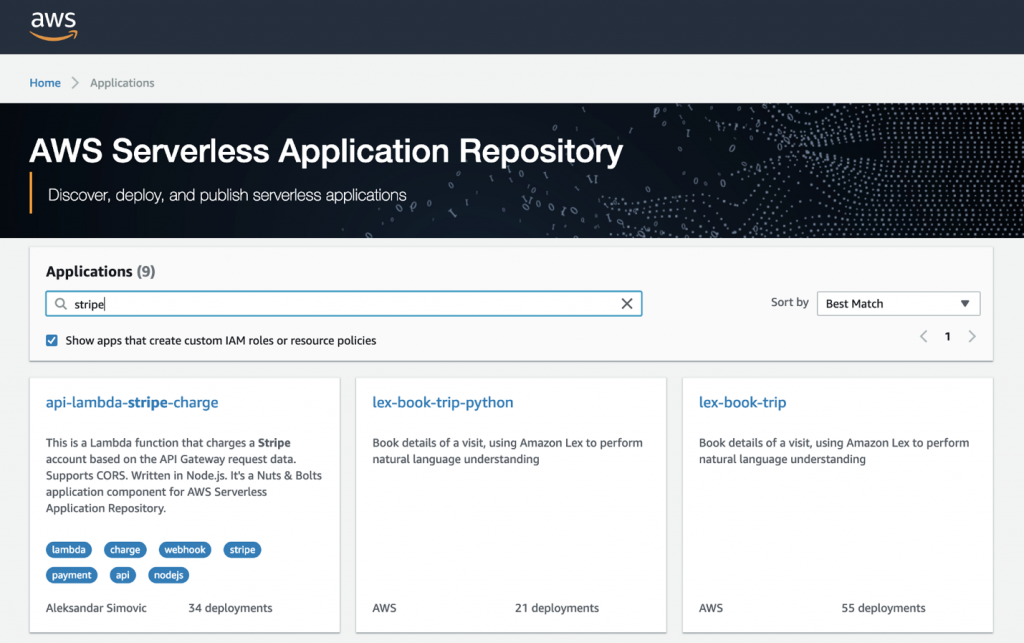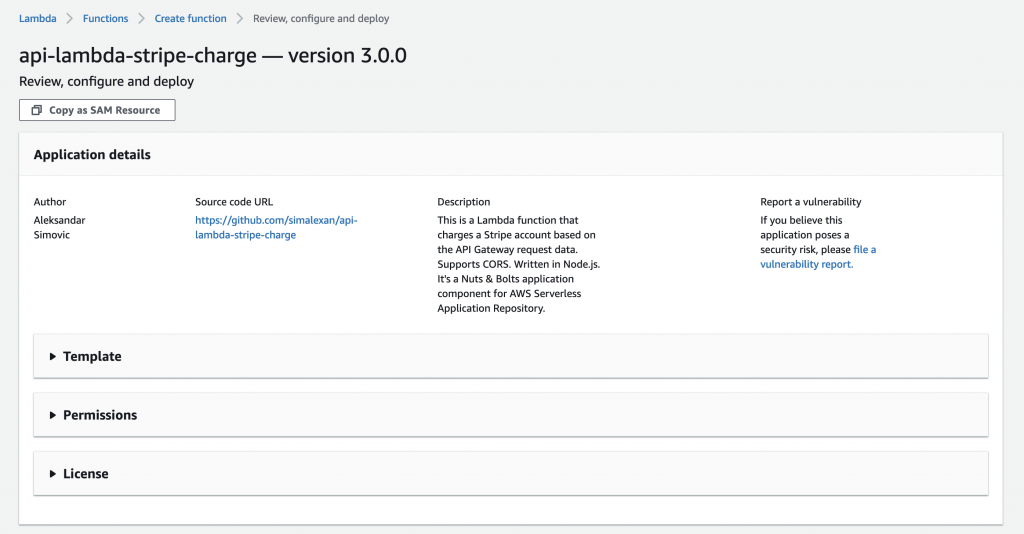Building serverless apps with components from the AWS Serverless Application Repository
Guest post by AWS Serverless Hero Aleksandar Simovic. Aleksandar is a Senior Software Engineer at Science Exchange and co-author of “Serverless Applications with Node.js” with Slobodan Stojanovic, published by Manning Publications. He also writes on Medium on both business and technical aspects of serverless.
Many of you have built a user login or an authorization service from scratch a dozen times. And you’ve probably built another dozen services to process payments and another dozen to export PDFs. We’ve all done it, and we’ve often all done it redundantly. Using the AWS Serverless Application Repository, you can now spend more of your time and energy developing business logic to deliver the features that matter to customers, faster.
What is the AWS Serverless Application Repository?
The AWS Serverless Application Repository allows developers to deploy, publish, and share common serverless components among their teams and organizations. Its public library contains community-built, open-source, serverless components that are instantly searchable and deployable with customizable parameters and predefined licensing. They are built and published using the AWS Serverless Application Model (AWS SAM), the infrastructure as code, YAML language, used for templating AWS resources.
How to use AWS Serverless Application Repository in production
I wanted to build an application that enables customers to select a product and pay for it. Sounds like a substantial effort, right? Using AWS Serverless Application Repository, it didn’t actually take me much time.
Broadly speaking, I built:
- A product page with a Buy button, automatically tied to the Stripe Checkout SDK. When a customer chooses Buy, the page displays the Stripe Checkout payment form.
- A Stripe payment service with an API endpoint that accepts a callback from Stripe, charges the customer, and sends a notification for successful transactions.
For this post, I created a pre-built sample static page that displays the product details and has the Stripe Checkout JavaScript on the page.
Even with the pre-built page, integrating the payment service is still work. But many other developers have built a payment application at least once, so why should I spend time building identical features? This is where AWS Serverless Application Repository came in handy.
Find and deploy a component
First, I searched for an existing component in the AWS Serverless Application Repository public library. I typed “stripe” and opted in to see applications that created custom IAM roles or resource policies. I saw the following results:
I selected the application titled api-lambda-stripe-charge and chose Deploy on the component’s detail page.
Before I deployed any component, I inspected it to make sure it was safe and production-ready.
Evaluate a component
The recommended approach for evaluating an AWS Serverless Application Repository component is a four-step process:
- Check component permissions.
- Inspect the component implementation.
- Deploy and run the component in a restricted environment.
- Monitor the component’s behavior and cost before using in production.
This might appear to negate the quick delivery benefits of AWS Serverless Application Repository, but in reality, you only verify each component one time. Then you can easily reuse and share the component throughout your company.
Here’s how to apply this approach while adding the Stripe component.
1. Check component permissions
There are two types of components: public and private. Public components are open source, while private components do not have to be. In this case, the Stripe component is public. I reviewed the code to make sure that it doesn’t give unnecessary permissions that could potentially compromise security.
In this case, the Stripe component is on GitHub. On the component page, I opened the template.yaml file. There was only one AWS Lambda function there, so I found the Policies attribute and reviewed the policies that it uses.
CreateStripeCharge:
Type: AWS::Serverless::Function
Properties:
Handler: index.handler
Runtime: nodejs8.10
Timeout: 10
Policies:
- SNSCrudPolicy:
TopicName: !GetAtt SNSTopic.TopicName
- Statement:
Effect: Allow
Action:
- ssm:GetParameters
Resource: !Sub
arn:${AWS::Partition}:ssm:${AWS::Region}:${AWS::AccountId}:parameter/${SSMParameterPrefix}/*
The component was using a predefined AWS SAM policy template and a custom one. These predefined policy templates are sets of AWS permissions that are verified and recommended by the AWS security team. Using these policies to specify resource permissions is one of the recommended practices for serverless components on AWS Serverless Application Repository. The other custom IAM policy allows the function to retrieve AWS System Manager parameters, which is the best practice to store secure values, such as the Stripe secret key.
2. Inspect the component implementation
I wanted to ensure that the component’s main business logic did only what it was meant to do, which was to create a Stripe charge. It’s also important to look out for unknown third-party HTTP calls to prevent leaks. Then I reviewed this project’s dependencies. For this inspection, I used PureSec, but tools like those offered by Protego are another option.
The main business logic was in the charge-customer.js file. It revealed straightforward logic to simply invoke the Stripe create charge and then publish a notification with the created charge. I saw this reflected in the following code:
return paymentProcessor.createCharge(token, amount, currency, description)
.then(chargeResponse => {
createdCharge = chargeResponse;
return pubsub.publish(createdCharge, TOPIC_ARN);
})
.then(() => createdCharge)
.catch((err) => {
console.log(err);
throw err;
});
The paymentProcessor and pubsub values are adapters for the communication with Stripe and Amazon SNS, respectively. I always like to look and see how they work.
3. Deploy and run the component in a restricted environment
Maintaining a separate, restricted AWS account in which to test your serverless applications is a best practice for serverless development. I always ensure that my test account has strict AWS Billing and Amazon CloudWatch alarms in place.
I signed in to this separate account, opened the Stripe component page, and manually deployed it. After deployment, I needed to verify how it ran. Because this component only has one Lambda function, I looked for that function in the Lambda console and opened its details page so that I could verify the code.
4. Monitor behavior and cost before using a component in production
When everything works as expected in my test account, I usually add monitoring and performance tools to my component to help diagnose any incidents and evaluate component performance. I often use Epsagon and Lumigo for this, although adding those steps would have made this post too long.
I also wanted to track the component’s cost. To do this, I added a strict Billing alarm that tracked the component cost and the cost of each AWS resource within it.
After the component passed these four tests, I was ready to deploy it by adding it to my existing product-selection application.
Deploy the component to an existing application
To add my Stripe component into my existing application, I re-opened the component Review, Configure, and Deploy page and chose Copy as SAM Resource. That copied the necessary template code to my clipboard. I then added it to my existing serverless application by pasting it into my existing AWS SAM template, under Resources. It looked like the following:
Resources:
ShowProduct:
Type: AWS::Serverless::Function
Properties:
Handler: index.handler
Runtime: nodejs8.10
Timeout: 10
Events:
Api:
Type: Api
Properties:
Path: /product/:productId
Method: GET apilambdastripecharge:
Type: AWS::Serverless::Application
Properties:
Location:
ApplicationId: arn:aws:serverlessrepo:us-east-1:375983427419:applications/api-lambda-stripe-charge
SemanticVersion: 3.0.0
Parameters:
# (Optional) Cross-origin resource sharing (CORS) Origin. You can specify a single origin, all origins with "*", or leave it empty and no CORS is applied.
CorsOrigin: YOUR_VALUE
# This component assumes that the Stripe secret key needed to use the Stripe Charge API is stored as SecureStrings in Parameter Store under the prefix defined by this parameter. See the component README. # SSMParameterPrefix: lambda-stripe-charge # Uncomment to override the default valueOutputs:
ApiUrl:
Value: !Sub https://${ServerlessRestApi}.execute-api.${AWS::Region}.amazonaws.com/Stage/product/123
Description: The URL of the sample API GatewayI copied and pasted an AWS::Serverless::Application AWS SAM resource, which points to the component by ApplicationId and its SemanticVersion. Then, I defined the component’s parameters.
- I set
CorsOriginto “*” for demonstration purposes. - I didn’t have to set the
SSMParameterPrefixvalue, as it picks up a default value. But I did set up my Stripe secret key in the Systems Manager Parameter Store, by running the following command:
aws ssm put-parameter --name lambda-stripe-charge/stripe-secret-key --value --type SecureString --overwrite
In addition to parameters, components also contain outputs. An output is an externalized component resource or value that you can use with other applications or components. For example, the output for the api-lambda-stripe-charge component is SNSTopic, an Amazon SNS topic. This enables me to attach another component or business logic to get a notification when a successful payment occurs. For example, a lambda-send-email-ses component that sends an email upon successful payment could be attached, too.
To finish, I ran the following two commands:
aws cloudformation package --template-file template.yaml --output-template-file output.yaml --s3-bucket YOUR_BUCKET_NAME
aws cloudformation deploy --template-file output.yaml --stack-name product-show-n-pay --capabilities CAPABILITY_IAM
For the second command, you could add parameter overrides as needed.
My product-selection and payment application was successfully deployed!
Summary
AWS Serverless Application Repository enables me to share and reuse common components, services, and applications so that I can really focus on building core business value.
In a few steps, I created an application that enables customers to select a product and pay for it. It took a matter of minutes, not hours or days! You can see that it doesn’t take long to cautiously analyze and check a component. That component can now be shared with other teams throughout my company so that they can eliminate their redundancies, too.
Now you’re ready to use AWS Serverless Application Repository to accelerate the way that your teams develop products, deliver features, and build and share production-ready applications.
Source: AWS News




